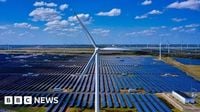China, the world’s largest emitter of greenhouse gases, has unveiled a landmark pledge to cut its economy-wide emissions by 7-10% from peak levels by 2035, marking the first time the country has set an absolute reduction target. President Xi Jinping made the announcement in a video address to a high-level United Nations climate summit in New York on September 24, 2025, declaring, “Green and low-carbon transformation is the trend of our times.”
China’s new target, while ambitious in its scope, has drawn a mixed response from world leaders, climate experts, and environmental advocates. The plan includes a dramatic ramp-up in renewable energy, aiming to expand wind and solar power capacity to more than six times its 2020 levels within the next decade. The country also plans to boost the share of non-fossil fuels in its domestic energy consumption to over 30% by 2035, increase forest stock to more than 24 billion cubic metres, and make electric vehicles mainstream in new vehicle sales.
“We will strive to do better,” President Xi said, emphasizing that China would “basically establish a climate-adaptive society” and expand its emissions trading market to cover all major emitting sectors. He called on developed nations to take the lead in climate action, pointedly referencing the United States for moving away from the Paris Agreement’s goals. “Despite some countries going against the trend, the international community should stay on the right track, maintain unwavering confidence, unwavering action, and undiminished efforts,” Xi urged, according to reporting from AP.
China’s announcement comes at a critical juncture. The world has already warmed about 1.3 degrees Celsius since the mid-19th century, inching ever closer to the Paris Agreement’s 1.5-degree limit. Under that 2015 accord, 195 nations—including China and the United States—are required to submit new, more stringent five-year plans to curb emissions. The deadline for these new commitments, covering cuts by 2035, was originally set for February but has now been extended to the end of September 2025, as countries scramble to finalize their pledges.
UN Secretary-General António Guterres stressed the urgency, saying, “We absolutely need countries to come [...] with climate action plans that are fully aligned with 1.5 degrees, that cover the whole of their economies and the whole of their greenhouse gas emissions.” He added, “It is essential that we have a drastic reduction of emissions in the next few years if you want to keep the 1.5 degrees Celsius limit alive,” as quoted by BBC.
China’s emissions are staggering in scale. In 2023, the country was responsible for nearly 14 billion tonnes of carbon dioxide-equivalent—more than a quarter of global emissions. A 10% reduction would equate to 1.4 billion tonnes a year, almost four times the UK’s total annual emissions. Yet, experts caution that even this significant cut falls short of what is needed to keep international climate goals within reach. According to Lauri Myllyvirta of the Centre for Research on Energy and Clean Air, “Anything less than 30% is definitely not aligned with 1.5 degrees.” Most credible scenarios for limiting warming to 1.5C would require China to cut its emissions by more than 50% by 2035.
Yao Zhe, global policy adviser at Greenpeace East Asia, echoed this concern: “Even for those with tempered expectations, what’s presented today still falls short. This 2035 target offers little assurance to keep our planet safe.” Nonetheless, Zhe acknowledged China’s track record of under-promising and over-delivering on climate goals, suggesting that the country could exceed its stated target. “Ultimately, actions do speak louder than words. But strong and consistent policy signals are an irreplaceable catalyst,” she told Climate Home News.
China’s rapid deployment of clean energy technologies has been remarkable. The nation smashed its previous pledge of reaching 1,200 gigawatts of wind and solar capacity by 2030, achieving that goal six years early in 2024. “The targets should be seen as a floor rather than a ceiling,” said Li Shuo, director of the China Climate Hub at the Asia Society Policy Institute. “China’s rapid clean tech growth […] could propel the country much further over the coming decade.”
Still, the country’s continued reliance on coal remains a sticking point. In 2024, China’s electricity generation from coal hit a new record, although early data from 2025 suggests a decline amid a surge in solar power. “There is also mounting evidence that the country’s emissions are plateauing, with this year’s levels expected to be lower than in 2024,” Li Shuo added, as reported by BBC.
Internationally, the announcement was met with a mix of praise for China’s progress and criticism for not going far enough. Bernice Lee, a distinguished fellow at Chatham House, argued, “China’s 2035 target simply isn’t representative of the pace of the energy transition in the country. There’s a case to be made that Beijing missed a trick in landing a more ambitious goal as it would have won broad global praise—a stark contrast to the US.”
That contrast was on full display at the summit, as US President Donald Trump dismissed climate change as a “con job” and ordered a second withdrawal from the Paris Agreement. The US, which is the world’s largest historical emitter and second-biggest current emitter behind China, has recently rolled back its climate commitments, drawing sharp rebukes from both allies and rivals.
Brazilian President Luiz Inacio Lula da Silva, who will host the COP30 climate conference in November 2025, warned, “No one is safe from the effect of climate change. Walls at borders will not stop droughts or storms. Nature does not bow down to bombs or warships. No country stands above another.”
Pakistani Prime Minister Muhammad Shehbaz Sharif offered a sobering reminder of the stakes, describing how recent floods have affected five million people in Pakistan and killed more than 1,000. “We are facing this calamity at a time when the scars of the 2022 floods that inflicted losses exceeding $30bn and displaced millions are still visible across our land,” he said.
UN climate chief Simon Stiell welcomed China’s new target, saying it “shows this acceleration of climate action, [clean energy] manufacturing and deployment will continue, and increase.” He described the scale of China’s expected investments as “unprecedented,” and pointed to the country’s “long and impressive record of meeting and surpassing its targets for climate change and clean energy.”
Despite the criticisms, China’s pledge is a pivotal moment in global climate negotiations. It signals the beginning of decarbonization after decades of rapid emissions growth and sets the stage for further ambition as the world heads into the COP30 summit. As Belinda Schäpe, policy analyst with CREA, observed, “I am quite confident that there will be an upgrade to this NDC in a couple of years, and hopefully that will be another reason for Xi Jinping to put something forward that gives us a bit more hope.”
With the world’s eyes on China and the clock ticking for the planet, the coming years will determine whether these ambitions are enough to bend the curve of global warming—or if more dramatic action will be needed to avert the worst impacts of climate change.





